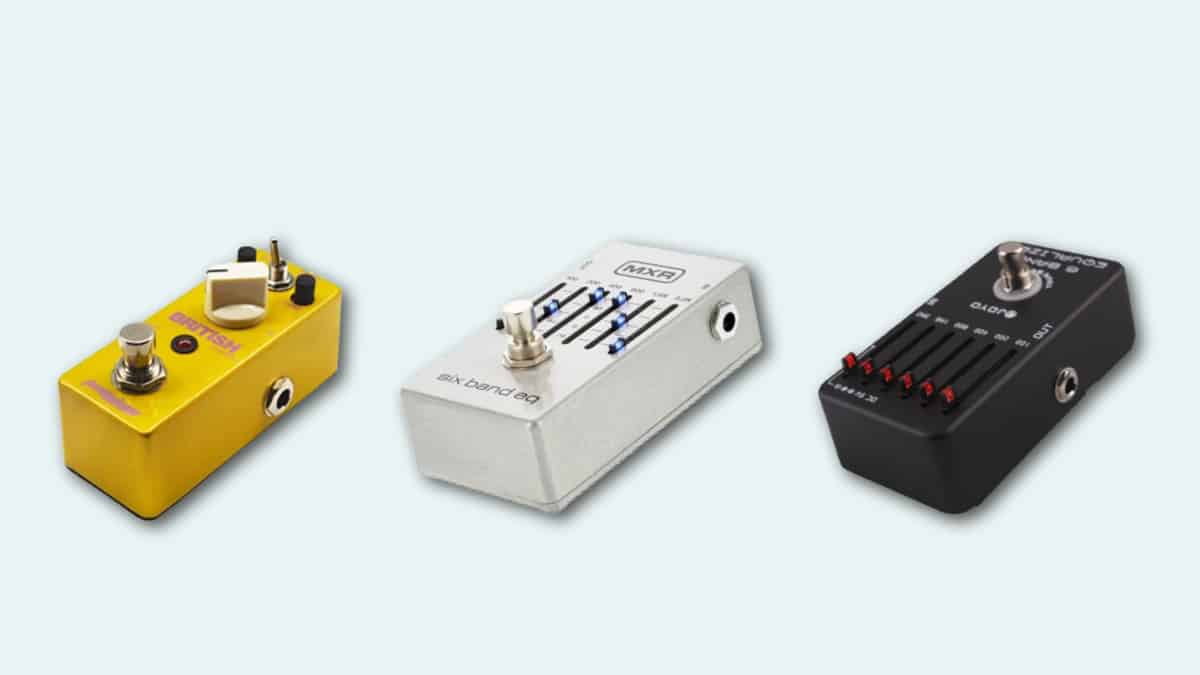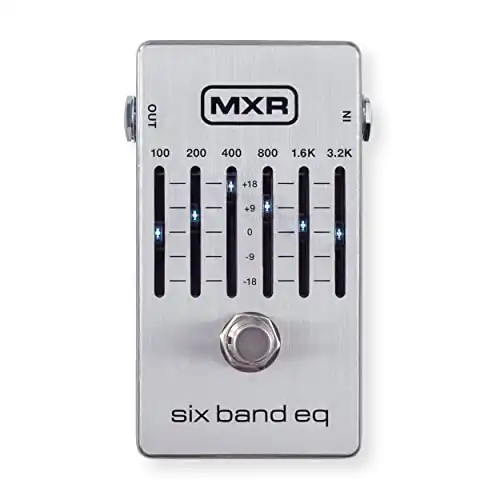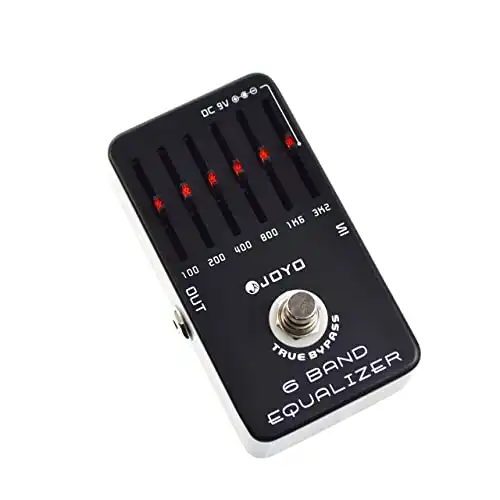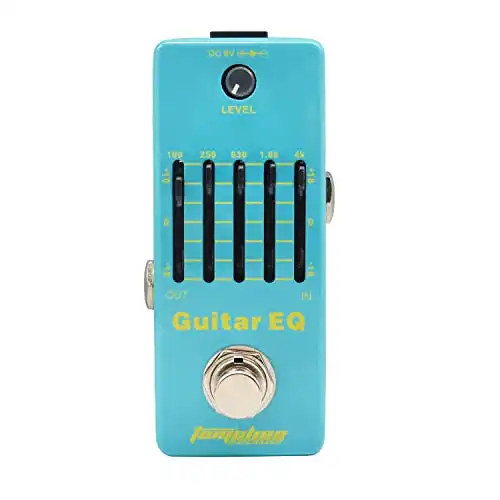You may be wondering: Can an EQ pedal help me sound like Eddie Van Halen, Slash, or Jack White? Surely isn’t it all about just plugging in and playing?
Well, hold your horses, riff-master general, EQ pedals are very important for getting that perfect shredding sound.
EQ pedals process the sound in your guitar as you play it. It allows you to adjust the volume of different frequencies – low (bass), medium or high.
You can adjust the settings of your EQ pedal to create a wide range of unique sounds.
But the best way to understand the difference between cranking up certain frequencies is not by reading about it, but by listening.
Here’s our man at Wampler pedals giving you a sweet run-down of EQ-distorted sounds.
EQ pedals come into their own during a live gig. They are perfect for the guitarist who wants complete control over their rig. Many, if not all of your favorite rock or blues artists have a sweet guitar rig. Why would anyone want to rely on the tech to achieve their signature sound?
Do you think David Gilmour relied on his sound tech when he was coming up with this angelic tone for “Comfortably Numb”?
Today I’ll share a list of some of the best EQ pedals, marked up in terms of budget, build quality and overall coolness.
I’ll also answer some common questions about EQ in the “buyer’s guide”.
So what are you waiting for, a backstage pass? Grab your 6-stringed riff maker and let’s have a look at our list of the best EQ pedals.
3 Best HQ Pedals in 2022
Top Pick: MXR M109S Six Band EQ Guitar Effects Pedal
The MXR M109S EQ pedal is my favorite on this list because it’s reasonably priced, quite versatile, and well-made. It seems like a great EQ pedal for beginners, given the price point and nice combination of features and sounds. It works well on most types of guitars and amplifiers, whether you prefer acoustic or electric guitars.
This pedal is an upgraded version of the past MXR EQ pedal, but with added noise reduction features that help minimizes noisy guitar pickups or other guitar pedals. The aluminum box is a simple but elegant design. If you’re looking for a fancy pedal design, this may not be for you. On the other hand, it has a bright blue LED lights that give you a little wow factor when you are in a dark room.
One major downside of this pedal is it has no master volume control, which makes it hard to adjust the overall volume of the pedal without moving its individual slider. Another drawback is that the lightweight case can be prone to movement on the floor if you don’t have a pedalboard.
Despite those potential drawbacks, I would still recommend this pedal for a beginner, or anyone who wants a simple clean-looking EQ pedal at an attractive price.
What I Like
- Affordable
- Good overall quality
- Impressive aluminum case
- Versatility – works with just about any electric and acoustic guitar
- Lightweight, quiet, does not eat batteries
- Good option for beginners
What I Don’t Like
- No master volume
- Small adjustments can do a lot of tone change
- May move around on the floor (due to light weight)
Best Luxury: JOYO JF-11 6 Band EQ Guitar Pedal
Okay, next up we have a pedal that has the facility to boost your rig and cover a very diverse range of frequencies, with 18 decibels to play with.
You also have additional LEDs for added visibility on stage. Introducing Joyo JF-11 6 Band EQ Guitar Pedal.
The high-tech interface and sleek body of this guitar are why we’ve chosen it as our best luxury option.
You simply get a larger amount of choice when it comes to tones on this pedal!
If you want an EQ pedal with a fairly beefy power supply to ensure that it won’t cut out on you during a solo, then we can heartily recommend the Joyo.
But why not listen to what the Joyo is capable of? Do you like those crisp notes on the distortion?
The 6 band EQ gives you an increased amount of settings that you can play with.
Ramp up the bass for that growly tone or drop it out for those precision clean notes.
The boosting and cutting of this EQ pedal is pretty impressive, with LED lights to help you navigate your settings while on stage.
However, some users have complained that the sound of this pedal can cut out when set to a high volume.
It also comes with a 9-volt battery pack in the housing. This means that you can rest easy – your EQ pedal is certainly not going to short during your favorite Iron Maiden solo.
What I Like
- The battery power boost inside the pedal will guarantee a longer life on the stage.
- A wide range of frequency options for an affordable price – okay, we lied, this pedal is actually very cheap to buy.
- It’s the sheer versatility of the unit that qualifies it for that luxury option!
- This is a bulky pedal with additional lights, making it an ideal choice for live guitarists.
- This product comes highly rated by users of Amazon, a testament to its abilities.
What I Don’t Like
- This pedal might be too chunky for some guitarists, especially ones who will be mainly wanting a pedal to improve their sound for home use
Best Budget: Tom’sline 5-Band equalizer guitar pedal
Our final option, the one we’ve chosen as the best EQ pedal for those on a budget, is the Tomsline 5-Band Equalizer.
This unit is compact and narrow, and we would certainly recommend it for those guitarists who are running out of space on their pedalboards.
This pedal has fewer EQ bands than our previous guitar pedal, although this certainly doesn’t mean that it underperforms in the tone department.
Well, why not listen to this quick demo for yourself before reading more?
That’s right, those 5 band settings certainly make all the difference when it comes to your guitar sound.
Also, with a super low price, you can see why the Tomsline features as our best budget pedal.
When it comes to EQ pedals, I prefer the slimmer units like this one, as I want to make more room for my distortion and delay pedals.
What can I say? I’m a big fan of the band Sleep and want those crunchy notes to sustain for over half an hour after hitting the strings.
Although an EQ pedal like this one does help you distinguish those notes, easing off on the bass and boosting the mid-tones will give you that extra clarity.
One downside: as with some of our previous pedals, some users have complained of hissing on each setting.
What I Like
- The price – considering the EQ bands available on this pedal, the price is great.
- We would recommend to new players who might feel slightly overwhelmed by too many frequency options.
- The 5 bands on the Tomsline will guarantee that you’ll be able to find the tone you’re looking for.
- The skinny design of this pedal makes it easy to slot in amongst your delay and distortion pedals.
- The Tomsline features several unique versions – bass, cream distortion, acoustic, reverb and British overdrive.
What I Don’t Like
- Some users have complained that this pedal isn’t durable and is very noisy.
Things to Consider before Buying an EQ Pedal
We can understand that you’re probably itching to pick up one of these pedals and start experimenting with frequencies to get your unique tone.
But hold on to your wild horses, Buddy Holly, there are some things you need to know about EQs.
A lot of the pedals you have might have some EQ settings already installed. Look to see if they have bass, mid or treble controls.
If so, you might save yourself a few dollars by sticking with your existing pedal settings.
However, if you want that iron-tight grip on your tone settings, especially when playing live, then you’ll definitely need your own frequency control deck.
By setting your frequencies before a show, you don’t have to worry. One click of the button and your settings will stay on throughout the entire set.
However, standalone EQ pedals have expanded to become an art form in themselves. Prepare to get technical, as we’re going to dive head-first into the world of frequency control.
How Graphic Is Graphic? The Different Types of EQ Pedal
You can break down EQ pedals into two distinct camps—Parametric EQ and Graphic EQ.
Without getting bogged down in unnecessary jargon, a parametric EQ is when pedals can be broken up into bands – as you have already seen on our pedals above.
Breaking the EQ up like this gives you a much greater degree of control over your EQ settings, allowing you to control the width and shape of each band – known as the Q.
Graphic EQs usually come with a simple knob turn that does not give you such a dynamic range of control over your frequencies.
Put as simply as we can: parametric gives you more bass, mid and treble options, whereas graphic EQs keep it as basic as possible.
For those who fancy delving further into this strange and complicated world of EQ magic, here’s an in-depth article on the differences between the two.
Fuzzy Or Fine? What You’ll Be Wanting An EQ Pedal For
You can use your EQ pedal in a variety of different ways. They are often referred to as ‘utility pedals’ and are commonly used to enhance the sound of your existing pedals.
If you are playing in a band setup, then some of the frequencies of your guitar could be interfering with the sound of another instrument. Easy solution – use an EQ pedal to cut out those pesky frequencies!
Here we have a more in-depth guide into pedals and their multi-dimensional properties. Have a cup of coffee ready, because the subject of sonics really is a mind-melter!
Often, some guitar sounds have been greatly improved by the use of an EQ pedal.
There are countless situations in which an EQ pedal can improve the life force of your guitar – it can cut out hissing and other noise that might be detrimental to your rig.
Here’s a lengthy science lesson about equalization and how it can be utilized in the studio or a live setting – featuring some incredibly hard-to-understand equations! Coffee at the ready!
For those visual learners out there, listen to this Queen Of The Stone Age track.
One of the ways Josh Homme and co. achieved this amazing stoner rock guitar sound is by driving the maxed-out mid-tones of an EQ pedal into the front of an amp.
If you cut out all your bands in favor of one single frequency, you can achieve very interesting sounds.
Removing bass and treble will boost your mid-tones and create a very filtered and reedy sound.
The luxury of having a good EQ pedal is that it allows you to experiment.
What Is The Frequency, Kenneth? – What To Look For In An EQ Pedal
If you’re a live guitar player, you might be wanting an EQ pedal that is well lit, making it easier to tweak your settings in the murky darkness of the stage.
Make sure you place your EQ pedal where you can easily access it. Of course, the taller you are, the easier it will be to reach.
Sliders and multi-band EQs will give you more choice and more control when it comes to selecting your sound, either live or in the studio.
You’ll rarely need an EQ pedal in the studio, as this can all be done through the main mixing desk.
However, using an EQ pedal will give you a much clearer idea of what sound you prefer when you do get to the mixing desk.
Here is a very quick Youtube tutorial that will help you when determining the EQ on a recorded guitar track in the studio.
FAQs
How will EQ affect the tone of your guitar?
Think of every note you hit on your guitar being like a footprint – each one is registered distinctly by our ears.
You’ll need to make sure that the footprint of each note is clearly defined, occupying its own space in the EQ spectrum in a way that doesn’t dominate over another or squash it underfoot.
A guitar is considered to be a midrange instrument and can often compete with instruments that occupy a similar sonic space – mainly saxophone, vocals and the toms on a set of drums.
You can use an EQ pedal to simply place the sound of your guitar in a slightly different space.
Pulling it off to the side by adding a little more bass or treble can really make it pop in the mix, guaranteeing it doesn’t get lost in a sludge of other mid-range instruments.
Here is another video by pedal specialists JHS pedals that will better highlight the necessity of EQ.
What Is the difference between multiple band EQs?
The more bands you have on your EQ pedal, the more precise you will be able to get your sound.
If you ever decide to go mammoth and pick up a 10-band EQ pedal, which is essentially a condensed mixing desk, then you can have more control when it comes to boosting your bass or weeding out the treble.
More EQ bands are simply for the musos of the world, guitarists who value that supervillain level of control.
However, for most people, a simple 3- or 5-band pedal will suffice in adjusting the basic frequencies of a guitar.
The Best Way To Equalize The Playing Field
EQ is possibly the most underrated part of getting your guitar sound, but in some ways, it is the most important.
Having a decent EQ pedal is a great way of shaping those guitar frequencies and removing notes that might be polluting your overall sound.
We hope that our best EQ pedals have helped you decide which pedal is the right one for your guitar.
Nobody wants a hiss cutting through when you’re trying to impress your friends with a note-perfect rendition of Stairway To Heaven! Spoil yourself and pick up an EQ pedal!
If you want to learn more about playing guitar, check out my post about the benefits of fretless guitars.







